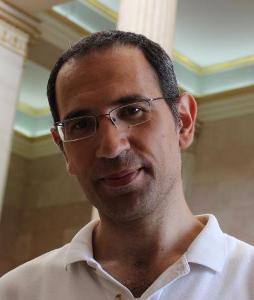Jan 28 2014
Mathematician Panayotis Kevrekidis at the University of Massachusetts Amherst recently won two international prizes that recognize his work on nonlinear waves and wave equations, which marries mathematics and physics to better understand how fiber optics communication systems work, for example. It may eventually help to make them more stable and robust.
 Practically speaking, Kevrekidis says, "Engineers get interested in waves like this, how they are propagated or, perhaps, how they can be stopped... but I like to understand the mathematics part. That's what is fascinating to me." (credit: University of Massachusetts Amherst)
Practically speaking, Kevrekidis says, "Engineers get interested in waves like this, how they are propagated or, perhaps, how they can be stopped... but I like to understand the mathematics part. That's what is fascinating to me." (credit: University of Massachusetts Amherst)
The Society for Industrial and Applied Mathematics' activity group on dynamical systems awarded Kevrekidis its John David Crawford Prize for "contributions to our understanding of localized solutions of nonlinear wave equations and for developing these for a variety of applications in nonlinear optics and condensed matter physics including Bose Einstein condensates and granular crystals."
In addition, the Academy of Athens, Greece, recently recognized the UMass Amherst mathematician with its Aristides F. Pallas Prize for his paper on "Nonlinear Waves in Lattices: Past, Present, Future," a review that included the mathematical analysis of dynamical models associated with optical waveguide arrays and granular crystal structures.
Kevrekidis says he thinks of his work as straddling mathematics and physics and always likes to keep in mind how his equations can be tested and applied in the real world. His rigorous mathematical descriptions of solitary wave behavior, for example, their interesting variations and interactions in heterogeneous configurations such as in two different materials, "take our basic understanding further," he says. "So later these calculations can be tested. Already some experiments have observed results that people didn't expect. We can produce states that experimentalists had not seen up to now."
Linear optical systems are chiefly used today for communicating information, but in much the same way that some power is lost when electricity travels along power lines, information can be garbled or lost when flowing along optical fibers, especially over long distances, Kevrekidis explains. More complex, nonlinear optics can strengthen the focus of solitary waves, also known as solitons, so they resist the tendency to disperse and eventually distort the signal.
Kevrekidis studies the stability and dynamics of solitary waves in periodic optical structures and how their discreteness can create robustness. Such nonlinear systems are not yet well understood. Kevrekidis' calculations show how introducing waveguides, that is wafers built into the optical system to channel pulses of information, can lead to the structural robustness of the ensuing solitary waves over long propagation distances.
"We knew that solitary waves are very robust, even if they collide or interact with other things like impurities in the line or other waves," he says. "They preserve their shape and character and keep the bit error rate low even over long distances. I contributed to the analysis and calculations that show that waveguides can help stabilize different families of solitary waves."
The Pallas award recognizes Kevrekidis' thorough mathematical analyses of fiber optics and granular crystals. The latter are chains of beads arranged in a lattice that holds them in a row or a two-dimensional array. The familiar desktop toy with swinging steel balls known as "Newton's cradle" is a simple example of a segment of a granular crystal lattice, he notes.
"You kick one of the beads and examine what kind of a pattern propagates down the chain. It turns out there is a nonlinear traveling wave that is very, very robust and predictable, and our mathematical models can accurately describe it."
His award-winning work describes how waves propagate through an elastic system of individual (granular) particles (balls), their displacement from equilibrium, how far each ball's center moves from its resting center when hit by its neighbor, how the amplitude evolves and the acceleration in relation to the next bead. "We know less about them in higher dimensions so I and my collaborators have also written equations for those situations and we are currently exploring them further," the mathematician notes.
Practically speaking, Kevrekidis says, "Engineers get interested in waves like this, how they are propagated or, perhaps, how they can be stopped. Let's say there is an earthquake, a wave propagating through a chain of heterogeneous materials, or a blast wave. Can I stop the transmission of a wave, like an earthquake or a blast? Or can I perhaps create protective armor that would minimize the effect or absorb the shock of a wave? Those sorts of questions are for engineers, but I like to understand the mathematics part. That's what is fascinating to me."